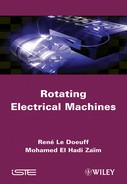Preface
Rotating electrical machines provide the basis of the electromechanical energy conversion and constitute the core of a wide scientific and technological field called “electrical engineering”. This discipline has seen a very important evolution with the extensive development of related fields: power electronics, analogical and digital control techniques, etc. This revolution has led to the generalization of electrical actuators in every industrial area as well as in everyday life. It has also modified the way the machines are used while, at the same time, simplifying their adaptation to new energy sources. Therefore, this evolution has to be taken into account in the teaching of electrical machinery.
The present text is the result of our long teaching and research experience in various universities' engineering schools, both in France and Algeria. It is intended mainly for Master's level students enrolled in electrical engineering programs. Its aims consists of providing readers with the essential knowledge of electrical machines, their structures, the ways they can be modeled and their implementation. This basic understanding should allow them to tackle with relative ease the study of transient phenomenon, speed variation and control of drives, and any other special applications.
This methodological approach was first proposed by Professor E. J. Gudefin in Nancy (France) in the 1960s. It is based on matrix representation of the machine equations using instantaneous values of electromagnetic variables.
This modeling approach is particularly suitable for the study of electrical machines fed by static converters; and it is necessary for the analysis of machines in transient regimes or any other study that uses Concordia and Park transformations, etc. It can also be used to establish classic steady state equations of electrical motors. The calculation of the instantaneous electromagnetic torque leads to a simple and convenient representation of the association machine-converter enabling an easy understanding of the continuous energy conversion phenomenon.
The main preliminary knowledge useful for reading this text (electromagnetism, sinusoidal systems, power electronics) is gathered in Chapter 1 (Main Requirements).
General concepts are established in Chapter 2 (Introduction to Rotating Electrical Machines) and are then used for different analyses of conventional machines: Synchronous Machines (Chapter 3), Induction Machines (Chapter 4) and Direct Current Machines (Chapter 5). Many examples describing the use of these machines with and without converters are also presented. Some traditional aspects (e.g. resistive starters, circle diagrams, etc.), which are of very little use today, are still presented because of their historical and pedagogical interest.
To make this book as factual as possible, we have illustrated it with many photographs that have been graciously provided by industrial firms; most of the curves, diagrams and characteristics are those of machines that really exist. Different field distribution plots describing electromagnetic behaviours of machines have been obtained from software codes developed in our research laboratory.
We would like to acknowledge all the individuals and organizations who took part in the realization of this book:
– Our colleagues from Electrical Engineering Department of Polytech'Nantes (France), particularly Professors M.F. Benkhoris and M. Machmoum.
– Professor Bernard Multon, from École Normale Supérieure de Cachan (France).
– Professor Guy Olivier from École Polytechnique de Montréal (Canada).
– The following firms: ECA EN, Converteam and STX France (previously, Aker Yards) for generously providing most of the photographs illustrating this book.
The authors wish to pay a particular tribute to their mentor, the late Professor Emeritus Edmond J. Gudefin (1923-1996).
